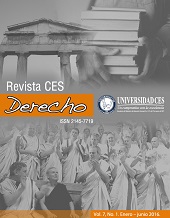Perspectiva de género en los fenómenos migratorios: estudio desde Europa y América Latina(Gender perspective in migratory phenomena: a study from Europe and Latin America)
Resumen
Este escrito reflexiona sobre la forma cómo la migración impacta en las mujeres, detallando algunos datos que permitan visibilizar a las mujeres como sujetos activos de la migración, pero sin desconocer, al mismo tiempo, el grado de vulnerabilidad en el que están expuestas. Para dicho estudio se contextualizará el escenario europeo, específicamente España, puntualizando su estrecha relación con el escenario latinoamericano, ya que son dos contextos ligados entre sí por razones históricas que convocan a reflexionar sobre el papel de las mujeres, sin desmeritar el papel de los hombres, en estos fenómenos migratorios.
Abstract:
This paper reflects on how migration impacts on women, detailing some data that make women visible as active subjects of migration, but without ignoring, at the same time, the degree of vulnerability in which they are exposed. This study will contextualize the European scenario, specifically Spain, highlighting its close relationship with the Latin American context, since they are two contexts linked together for historical reasons that call for reflection on the role of women without demeaning the role of men, in these migratory phenomena.
DOI: http://dx.doi.org/10.21615/cesder.7.2.10
Descargas
Referencias bibliográficas
Martínez Rus F, Pradíes Ramiro G, Suárez García MJ, Rivera Gómez B. Cerámicas dentales: clasificación y criterios de selección. RCOE. 2007.
Álvarez-Fernández MÁ, Peña-López JM, González-González IR, Olay-García MS. Características generales y propiedades de las cerámicas sin metal. RCOE. 2003.
Hoffmann-Axthelm W. The writing of dental history: a commentary. J Am Dent Assoc. 1974;88:1355–7.
Swank S. History of the dental profession. Pa Dent J (Harrisb). 75:19–24.
Nieto-Galan A. The history of science in Spain. A critical overview. Nuncius. 2008;23:211–36.
Iovino RP. Democracy and dentistry. A medical profession within a democracy. N Y State Dent J. 2006;72:18–20.
Kovalecz G. The evolution of school dentistry. Orv Hetil. 2006;147:1043–4.
Pott S. Literature and medicine in the 18th century: from new research criticism to medical writing. Gesnerus. 2006;63:127–43.
Torres Durán, Edgar; Novoa Diaz JL. Implantología oral y reconstructiva. Implantología. 2014;1(2):7.
Xin XZ, Xiang N, Chen J, Wei B. In vitro biocompatibility of Co-Cr alloy fabricated by selective laser melting or traditional casting techniques. Mater Lett. 2012;88:101–3.
Quante K, Ludwig K, Kern M. Marginal and internal fit of metal-ceramic crowns fabricated with a new laser melting technology. Dent Mater. 2008;24:1311–5.
Yeo IS, Yang JH, Lee JB. In vitro marginal fit of three all-ceramic crown systems. J Prosthet Dent. 2003;90:459–64.
Miyazaki T, Hotta Y, Kunii J, Kuriyama S, Tamaki Y. A review of dental CAD/CAM: current status and future perspectives from 20 years of experience. Dent Mater J. 2009;28:44–56.
Vilarrubí, Alejandra; Pebé, Pablo; Rodríguez A. Prótesis fija convencional libre de metal: tecnología CAD CAM-Zirconia, descripción de un caso clínico. Odontoestomatologia. 2011;13(18).
Vagkopoulou T, Koutayas SO, Koidis P, Strub JR. Zirconia in dentistry: Part 1. Discovering the nature of an upcoming bioceramic. Eur J Esthet Dent. 2009;4:130–51.
Oliva J, Oliva X, Oliva JD. Five-year success rate of 831 consecutively placed Zirconia dental implants in humans: a comparison of three different rough surfaces. Int J Oral Maxillofac Implants. 25:336–44.
Crisp RJ, Cowan AJ, Lamb J, Thompson O, Tulloch N, Burke FJT. A clinical evaluation of all-ceramic bridges placed in UK general dental practices: first-year results. Br Dent J. 2008;205:477–82.
Beuer F, Schweiger J, Edelhoff D. Digital dentistry: an overview of recent developments for CAD/CAM generated restorations. Br Dent J. 2008;204:505–11.
Molin MK, Karlsson SL. Five-year clinical prospective evaluation of zirconia-based Denzir 3-unit FPDs. The International journal of prosthodontics.
Gonzalo E, Suárez MJ, Serrano B, Lozano JFL. Marginal fit of Zirconia posterior fixed partial dentures. Int J Prosthodont. 21:398–9.
Edelhoff D, Florian B, Florian W, Johnen C. HIP zirconia fixed partial dentures--clinical results after 3 years of clinical service. Quintessence international (Berlin, Germany : 1985). 2008. p. 459–71.
Lara Téllez, Lourdes; Ochoa Tataje, Jesús; Gaitán Velásquez, Jorge; Herrera Cisneros M. Rehabilitación con coronas completas de metal-cerámica y prótesis parciales removibles convencionales. Odontol Sanmarquina. 2008;11(2):5.
Mallat Desplats E. Prótesis parcial removible y sobredentaduras. Elsevier España; 2003. 656 p.
Rendón Yudice R. Prótesis parcial removible. Conceptos actuales, atlas de diseño. Panamericana; 2006. 186 p.
Chen J, Zhang Z, Chen X, Zhang C, Zhang G, Xu Z. Design and manufacture of customized dental implants by using reverse engineering and selective laser melting technology. J Prosthet Dent [Internet]. 2014; Available from: http://www.ncbi.nlm.nih.gov/pubmed/24939253
Figliuzzi M, Mangano F, Mangano C. A novel root analogue dental implant using CT scan and CAD/CAM: Selective laser melting technology. Int J Oral Maxillofac Surg. 2012;41:858–62.
Mangano FG, Cirotti B, Sammons RL, Mangano C. Custom-made, root-analogue direct laser metal forming implant: A case report. Lasers Med Sci. 2012;27:1241–5.
Pérez Hortelano, A.B.; Romeo Rubio, M.; Martínez de Parga J. Cerámicas utilizadas en los sitemas CAD/CAM. Rev Int Prótesis Estomatológica Edición Hispanoam. 2006;8(1):4.
Caparroso Pérez, Carlos; Duque Vargas J. Cerámicas y sistemas para restauraciones CAD-CAM: una revisión. Rev Fac Odontol Univ Antioquia. 2010;22(1):88–108.
Nevárez Rascón, Alfredo; Nevárez Rascón, Martina; Bologna Molina, Ronell; Serena Gómez E. Características de los materiales cerámicos empleados en la práctica odontológica actual. Rev ADM. 2012;69(4):157–63.
Rekow ED. Dental CAD/CAM systems: a 20-year success story. J Am Dent Assoc. 2006;137 Suppl:5S – 6S.
Fasbinder DJ. Digital dentistry: innovation for restorative treatment. Compend Contin Educ Dent. 2010;31 Spec No:2–11; quiz 12.
Ender A, Mehl A. Full arch scans: conventional versus digital impressions--an in-vitro study. Int J Comput Dent. 2011;14:11–21.
Ziegler M. Digital impression taking with reproducibly high precision. Int J Comput Dent. 2009;12:159–63.
Syrek A, Reich G, Ranftl D, Klein C, Cerny B, Brodesser J. Clinical evaluation of all-ceramic crowns fabricated from intraoral digital impressions based on the principle of active wavefront sampling. J Dent. 2010;38:553–9.
Kachalia PR, Geissberger MJ. Dentistry a la carte: in-office CAD/CAM technology. J Calif Dent Assoc. 2010;38:323–30.
Christensen GJ. Impressions are changing: deciding on conventional, digital or digital plus in-office milling. J Am Dent Assoc. 2009;140:1301–4.
Touchstone A, Nieting T, Ulmer N. Digital transition: the collaboration between dentists and laboratory technicians on CAD/CAM restorations. Journal of the American Dental Association (1939). 2010. p. 15S – 9S.
Mörmann WH. The evolution of the CEREC system. J Am Dent Assoc. 2006;137 Suppl:7S – 13S.
Shillingburg, Herbert T., Jr; Hobo, Sumiya; Whitsett, Lowell D; Jacobi R. Fundamentos de protesis fijas. QUINTESSENCE; 2010. 582 p.
Fu CC, Hsu YT. A comparison of retention characteristics in prefabricated and custom-cast dental attachments. J Prosthodont. 2009;18:388–92.
Pinzón LM, Frey GN, Winkler MM, Tate WH, Burgess JO, Powers JM. Retention of gold alloy crowns cemented with traditional and resin cements. Int J Prosthodont. 22:351–3.
Ayad MF, Johnston WM, Rosenstiel SF. Influence of dental rotary instruments on the roughness and wettability of human dentin surfaces. J Prosthet Dent. 2009;102:81–8.
Jorgensen K. The relationship between retention and convergence angle in cemented veneer crowns. Acta Odontol Scand [Internet]. 1955;13:35–40. Available from: http://www.ncbi.nlm.nih.gov/pubmed/14398174
Shamseddine L, Eid R, Homsy F, Elhusseini H. Effect of tapering internal coronal walls on fracture resistance of anterior teeth treated with cast post and core: In vitro study. J Dent Biomech [Internet]. 2014;5. Available from: http://dbm.sagepub.com/lookup/doi/10.1177/1758736014547550
Yang H-S, Park J-M, Han J-S, Lee J-B, Kim S-H, Yeo I-S. Measuring abutment convergence angles using stereovision dental image processing system. J Adv Prosthodont [Internet]. 2014;6:259. Available from: http://synapse.koreamed.org/DOIx.php?id=10.4047/jap.2014.6.4.259
Smyd ES. Advanced Thought in Indirect Inlay and Fixed Bridge Fabrication. J Am Dent Assoc [Internet]. 1944;31:1052–8. Available from: http://linkinghub.elsevier.com/retrieve/pii/S0002817744150070
Cho H, Michalakis KX, Kim Y, Hirayama H. Impact of interproximal groove placement and remaining coronal tooth structure on the fracture resistance of endodontically treated maxillary anterior teeth. J Prosthodont. 2009;18:43–8.
Ohlmann B, Gruber R, Eickemeyer G, Rammelsberg P. Optimizing preparation design for metal-free composite resin crowns. J Prosthet Dent. 2008;100:211–9.
Medić V, Obradović-Djuričić K. Factors influencing bonding fixed restorations. Srp Arh Celok Lek. 2008;136:232–40.
Zena RB, Khan Z, von Fraunhofer JA. Shoulder preparations for collarless metal ceramic crowns: hand-planning as opposed to rotary instrumentation. J Prosthet Dent. 1989;62:273–7.
Schmid, Steven; Kalpakjian S. Manufactura ingeniería y tecnología. Procesos de manufactura. Pearson; 2002. 635 p.
Anusavice KJ. Ciencia de los materiales dentales. Elsevier España; 2004. 853 p.
Ardila Marín J. Manufactura por capas: prototipado rápido [Internet]. Universidad Nacional de Colombia; 2010. Available from: http://www.imprimalia3d.com/recursos/manufactura-capas-prototipado-r-pido
Coba Salcedo, Milton; Serres Moliner E. Estudio comparativo de dos tecnologías de mecanizado rápido; Coproinmold y sinterizado selectivo por láser. Rev Fac Ing Univ Antioquia. 2006;38.
Ruiz J-L, Kurtz R. Are full-coverage crowns overutilized? Supragingival partial-coverage designs as a first option. Dent Today. 2014;33:122,124–5.
Tsukada G, Sueyoshi H, Kamibayashi H, Tokuda M, Torii M. Bending strength of zirconia/porcelain functionally graded materials prepared using spark plasma sintering. J Dent. 2014;
Beier US, Dumfahrt H. Longevity of silicate ceramic restorations. Quintessence Int [Internet]. 2014;45:637–44. Available from: http://www.ncbi.nlm.nih.gov/pubmed/25126640
Patel DR, O’Brien T, Petrie A, Petridis H. A Systematic Review of Outcome Measurements and Quality of Studies Evaluating Fixed Tooth-Supported Restorations. J Prosthodont. 2014;23:421–33.
??ilo M, Hardang AD, Ulsund AH, Gjerdet NR. Fractographic features of glass-ceramic and zirconia-based dental restorations fractured during clinical function. European Journal of Oral Sciences. 2014;
Mufti AS. Clinical efficacy of the conventional glass ionomer cement and resin modified glass ionomer cement in primary molars. J Ayub Med Coll Abbottabad. 2014;26:587–90.
Shamseddine L, Eid R, Homsy F, Elhusseini H. Effect of tapering internal coronal walls on fracture resistance of anterior teeth treated with cast post and core: In vitro study [Internet]. Journal of dental biomechanics. 2014. p. 1758736014547550. Available from: http://europepmc.org/abstract/MED/25342986
Yang H-S, Park J-M, Han J-S, Lee J-B, Kim S-H, Yeo I-S. Measuring abutment convergence angles using stereovision dental image processing system. J Adv Prosthodont [Internet]. 2014;6:259. Available from: http://synapse.koreamed.org/DOIx.php?id=10.4047/jap.2014.6.4.259
Seo Y-J, Kwon T-K, Han J-S, Lee J-B, Kim S-H, Yeo I-S. The reliability of an easy measuring method for abutment convergence angle with a computer-aided design (CAD) system. J Adv Prosthodont [Internet]. 2014;6:185. Available from: http://synapse.koreamed.org/DOIx.php?id=10.4047/jap.2014.6.3.185
Potts RG, Shillingburg HT, Duncanson MG. Retention and resistance of preparations for cast restorations. J Prosthet Dent. 1980;43:303–8.
Coelho PG, Silva NR, Thompson VP, Rekow D, Zhang G. Effect of proximal wall height on all-ceramic crown core stress distribution: a finite element analysis study. Int J Prosthodont. 22:78–86.
Dudley JE, Richards LC, Abbottf JR. Retention of cast crown copings cemented to implant abutments. Aust Dent J. 2008;53:332–9.
Suárez García MJ. Evaluación del sellado marginal de coronas de titanio colado y mecanizado con dos líneas de determinación [Internet]. Universidad Complutense de Madrid; 2005. Available from: http://eprints.ucm.es/tesis/odo/ucm-t27018.pdf
Witkowski S, Komine F, Gerds T. Marginal accuracy of titanium copings fabricated by casting and CAD/CAM techniques. J Prosthet Dent. 2006;96(1):47–52.
Descargas
Publicado
Cómo citar
Número
Sección
Licencia
| Estadísticas de artículo | |
|---|---|
| Vistas de resúmenes | |
| Vistas de PDF | |
| Descargas de PDF | |
| Vistas de HTML | |
| Otras vistas | |



